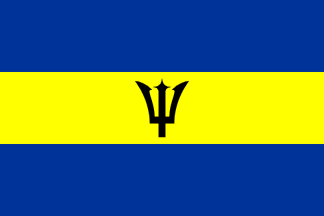 (2:3)
(2:3)
image by Željko Heimer, 24 Febuary 2001

Last modified: 2006-01-21 by dov gutterman
Keywords: barbados | caribbean | trident | barb | west indies | fig tree | dolphin | pelican | pelican island | sugarcane | st. andrew | west indian federation |
Links: FOTW homepage |
search |
disclaimer and copyright |
write us |
mirrors
 (2:3)
(2:3)
image by Željko Heimer, 24 Febuary 2001
Official Name: Barbados
Capital: Bridgetown
Location: Caribbean
Government Type: Constitutional Monarchy (Queen
Elizabeth II)
Flag adopted: 30
November 1966
Designer: Grantley Prescod
Coat of arms adopted: 21 December 1966
ISO Code: BB
See also:
National flag. CSW/C-- 2:3 - Different sources differ in the
representation of the shape of the trident - possibly it is not
entirely defined or it may have changed over the years. All
sources seem to agree that the blue shade is lighter then the
standard blue used in the UJ (and in the Governor
General of Barbados flag) and yellow is in all representation
dark, almost orange. [smi80]
designate the flag as CSW/CSW, but since BB has no navy and since
(as it seems) the white ensign was introduced in the mean time (Naval and Coast Guard Ensign), the usage
designation seems to be all right as shown in Album 2000.
Željko Heimer, 24 Febuary 2001
Barbados flag colour shades from Album 2000 [pay00] are:
Pantone --- CMYK
B 280c --- 100-70-0-20
Y 123c --- 0-30-90-0
Santiago Dotor, 26 Febuary 2001
When I was in Barbados I checked the flag. The blue was
uniformly a medium-dark; darker than that usually seen in the
French flag, for example, but lighter than that of the US. I'd
simply call it B+ in quick descriptions. Likewise the yellow is
Y+, rather rich in tone.
Al Kirsch, 26 Febuary 2001
According to Politikens Flagbook the flag was the winning
proposal in a nation-wide contest, and was designed by an
Grantley Prescod, teacher of arts.
Peter Hans van den Muijzenberg, 7 October 2001
In English heraldry a "barbe" is a trident with
barbed points, hence the world's only canting national flag (as
far as I know), Barbados.
James Dignan, 9 November 2004
The word "Barbados" comes from Portuguese (or maybe
Spanish) meaning "beard [ones]", refering to local
mangove-like sea-side trees. So, as we know, the trident is more
recent than the name, and its etymology is convoluted (though not
false).
Antonio Martins, 9 November 2004
The blue on the left is for the sky, the gold for the sand,
the right blue for the sea. The trident in the middle represents
the break with England at independence - the trident is broken,
thus only the top is showing. The name of Barbados comes from the
Portuguese name Os Barbados meaning bearded one, because
of the bearded fig tree that used to cover the island. The three
points of the trident represent the three principles of democracy
- government of, for and by the people.
James Dignan, 22 November 1995, "Amanda" from
Barbados, 20 May 1998
According to Politikens Flagbook (translated by me):
"Prescod explains the stripes as symbol for the blue sea and
the golden sand, that encircle the island. The trident is taken
from the previous flag-charge, which showed Britannia holding a
trident (symbol for her rule
over the seas)). Here, the trident is without shaft as a symbol
for the break with the colonial past. Simultaneously it
symbolizes the sea god Neptune and refelcts the sea's large
significance for Barbados."
Peter Hans van den Muijzenberg, 7 October 2001
from the official site of the Barbados government :

image by Željko Heimer and António
Martins-Tuválkin, 14 December 2005
When reporting BB stamps with flags, Ron Lahav
mentioned a Barbados flag with horizontal rather than vertical
stripes, which is shown in stamp
SG 677, issued in 1981 for the Carifesta (Caribbean Festival
of Arts), Barbados.
I cannot swear that the thing in the middle of this
blue-yellow-blue horizontal equial triband is a black trident,
but there's something there alright.
António Martins-Tuválkin, 14 December 2005
The Government of Barbados Information Service does proclaim
that it is the Barbados flag at <www.barbados.gov.bb>.
Ned Smith, , 14 December 2005
Barbados is divided to 11 parishes. There are no known flags
of those parishes. The parishes are:
- Saint Andrew
- Christ Church
- Saint Peter
- Saint George
- Saint John
- Saint Lucy
- Saint Michael
- Saint Joseph
- Saint Philip
- Saint James
- Saint Thomas
List based on Administrative
divisions of the World.
Dov Gutterman, 25 October 2004